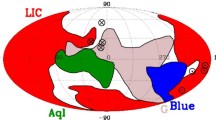Abstract
We describe a new model of the chromosphere based on Lyman-continuum observations by Harvard spectrometers aboard the satellites OSO 4 and OSO 6. The model assumes (a) that a random distribution of optically thick inhomogeneities overlies a plane-parallel homogeneous atmosphere, and (b) that the Lyman continuum in the chromosphere is optically thick and the only significant opacity source between 600 and 912 Å.
The temperature, gas pressure, electron pressure, particle densities, and b 1 (the hydrogen ground-state departure coefficient) are calculated as a function of height in the chromosphere.
The model reproduces the observed quiet-region intensities in the Lyman continuum. The inhomogeneous structures, which we believe to be spicules, are inferred to be optically thick in the Lyman continuum and to have a source function below that of the mean chromosphere. If they are also optically thick in the free-free (millimeter) continuum and cooler than about 5000K, they could produce the observed limb darkening at 1 and 3 mm. Such low temperatures are at odds with current spicule models, but could exist in the cores of spicules.
The Lyman-continuum emission shortward of 750 Å shows an excess emission over that predicted by the above model. This is found to be consistent with the existence of a temperature plateau with T ∼ 22000K in the very high chromosphere.
Similar content being viewed by others
References
Athay, R. G.: 1966, Astrophys. J. 145, 784.
Athay, R. G.: 1969, Solar Phys. 9, 51.
Beckers, J. M.: 1968, Solar Phys. 3, 367.
Brault, J. W.: 1971, private communication.
Gingerich, O., Noyes, R. W., Kalkofen, W., and Cuny, Y.: 1971, Solar Phys. 18, 347.
Giovanelli, R. G.: 1967, Australian J. Phys. 20, 81.
Henze, Jr., W.: 1969, Solar Phys. 9, 65.
Kundu, M. R.: 1971, private communication.
Linsky, J. L. and Avrett, E. H.: 1970, Publ. Astron. Soc. Pacific 82, 169.
Noyes, R. W. and Kalkofen, W.: 1970, Solar Phys. 15, 120.
Purcell, J. D. and Tousey, R.: 1969, Bull. Am. Astron. Soc. 1, 290.
Reeves, E. M. and Parkinson, W. H.: 1970, Astrophys. J. Suppl. 21, 1.
Thomas, R. and Athay, R. G.: 1961, Physics of the Solar Chromosphere, Interscience Publ., New York.
Tousey, R.: 1971, Phil. Trans. Roy. Soc. London A 270, 59.
Vernazza, J. E. and Avrett, E. H.: 1971 (in preparation).
Withbroe, G. L.: 1970a, Solar Phys. 11, 42.
Withbroe, G. L.: 1970b, Solar Phys. 11, 208.
Author information
Authors and Affiliations
Rights and permissions
About this article
Cite this article
Vernazza, J.E., Noyes, R.W. Inhomogeneous structure of the solar chromosphere from Lyman-continuum data. Sol Phys 22, 358–374 (1972). https://doi.org/10.1007/BF00148702
Received:
Issue Date:
DOI: https://doi.org/10.1007/BF00148702




